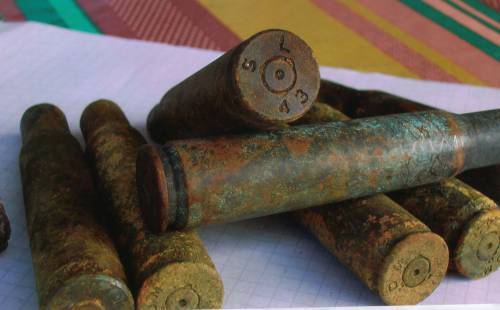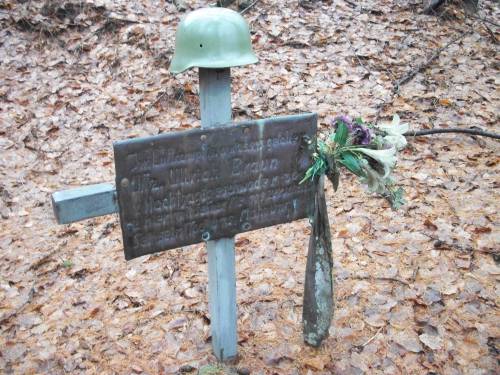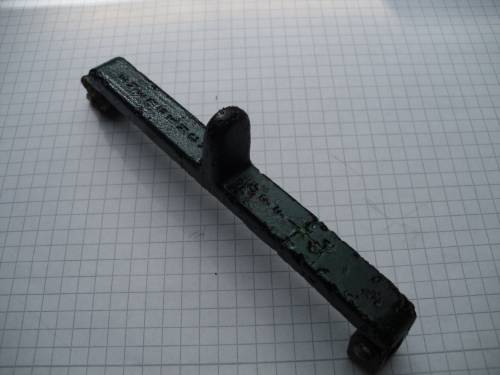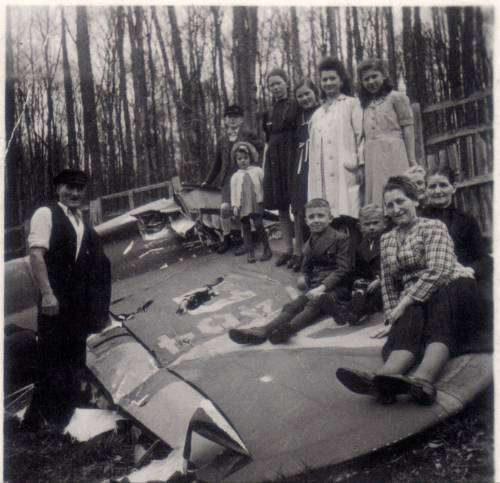Wandern und Wracksuche im Spessart
- von Manfed Rassau 2017
Der Spessart östlich von Aschaffenburg lädt zu ausgedehnten Spaziergängen in Jahrhunderte alten Buchenwäldern ein.
Ganz gleich, zu welcher Jahreszeit.
Fremde sollen sich hier schon verlaufen haben. Es gibt aber immer etwas Neues zu entdecken:
Ob nun Hirsche im Hafenlohrtal oder diverse Gedenkstätten entlang des Eselsweges.

Patronenhülsen aus dem Kampfsatz eines B-17-Bombers nach 70 Jahren im Waldboden bei Weibersbrunn
Foto: M. Rassau

Foto: O. Väht
Wie kommen Hülsen des Kalibers 0.50 aus dem 2. Weltkrieg nach Weibersbrunn, fragte ich mich.
Der mit 86 Jahren jung gebliebene rüstige Weibersbrunner Otmar Väht zeigte mir ein Foto aus seiner Jugendzeit.
Aufgenommen wurde es 1944 in Weibersbrunn am Weißenstein.
Eindeutig ein Maschinengewehr aus dem Heckstand einer amerikanischen „Fliegenden Festung“ B-17 F.

Foto: pallas.be
Keiner wußte, woher das Wrackteil stammte.
Also suchte ich nach Leuten, die noch Erinnerungen an jene Zeit hatten, als amerikanische Bomberschwärme mit grausigem Brummen und tödlicher Fracht hoch über dem Spessart hinwegflogen.
Fast alle berichteten mir auf Anhieb von einem deutschen Postflugzeug, das bereits vor dem Krieg am Echtersphal zerschellte.
Zum Hergang war nach 80 Jahren kaum etwas zu erfahren.
In einer Ausgabe des „Spessartbundes“ vom November 1932 fand ich 2013 einen erschütternden Bericht des Aschaffenburger Reporters Max Brech (1887-1958) zum Absturz der Junkers F13 D-724.
Ich fand das so aufschlussreich und teilte meine Erkenntnisse im Flugzeugforum mit.
http://www.flugzeugforum.de/threads/81181-Absturz-einer-Junkers-F13-im-Hochspessart

Foto: M.Rassau
Am Eselsweg in Richtung Dammbach soll sich das Kreuz eines im Krieg umgekommenen Fliegers befinden, erfuhr ich weiter. Mit dem Mountainbike brauchte ich von Weibersbrunn eine gute Stunde, bis ich die Stelle direkt neben dem Wanderweg gefunden hatte.
Ein Kreuz, behütet mit einem Stahlhelm und einer Kupferblechtafel. Darauf der Name des deutschen Jagdfliegers Ullrich Braun, der hier 1943 umkam. Das Datum passte aber nicht zu meinen Erkenntnissen. Nach mehreren Tagen Sucherei lernte ich Willibald Kempf in Dammbach kennen. Er war der Initiator des Gedenkortes. Ich versprach, bei der Wehrmachtsauskunftstelle (WAST) Berlin nachzufragen um Details zu erfahren. Als ich nach vielen Wochen endlich das amtliche Ergebnis hatte, fuhr ich wieder zu Herrn Kempf und überreichte ihm meine Fakten. Er schenkte mir, weil ich in Weibersbrunn wohnte, ein Foto, das mit unbekanntem Datum bei Weibersbrunn aufgenommen worden war.
Das Foto zeigt eine ganze Familie, scheinbar bei einem Sonntagsspaziergang, auf einem Wrackteil posierend. Darauf war gut zu erkennen ein großer Buchstabe D.
D, wie Deutschland, dachte ich und war mir sicher, dass es das Wrack des Postflugzeuges D-724 wäre und hatte es bald wieder vergessen.
Auch Herr Adam Roth erzählte mir 2012 von Wrackteilen eines US-Bombers, die 1944 an der Beerwaldstraße lagen. Als Kind hatte er dort mit seinen Kumpels ein Maschinengwehr ausgebaut und es später im Wald vergraben. Unweit des Ausflugslokals Echtersphal, südlich der alten Bundesstraße nach Würzburg, waren mit bloßem Auge noch nach 70 Jahren die Spuren eines Flugzeugabsturzes auszumachen. Das Internet hat die Recherchen nach Dokumenten zu den amerikanischen Verlusten im 2. Weltkrieg sehr erleichtert. Schnell konnte ich aus den US-Archivdokumenten lernen, daß bei den Luftangriffen der US-Bombenflieger auf die strategisch wichtigen Kugellagerfabriken in Schweinfurt gleich mehrere „Flying Fortress“ -Bomber über den Spessartwäldern vom Himmel gestürzt waren. So geschehen bei Waldaschaff, Keilberg, Bischbrunn, Straßlücke, Glasofen und auch bei Weibersbrunn. Bald darauf lernte ich Herrn Fleckenstein kennen. Der junggebliebene Rentner Jahrgang 1927 berichtete mir, wie er als junger Waldarbeiter den Absturz eines deutschen Flugzeuges im Karlsbuch unterhalb des Geiersberges erlebte. Es soll zwei Tote gegeben haben, wußte er noch.
Ich erfuhr bei meinen ersten Nachforschungen, daß sich mit dieser Thematik schon längere Zeit zwei andere Luftfahrtarchäologen beschäftigten.
Einer vertrat die Meinung, daß damals beim Test einer deutschen Geheimwaffe auf dem höchsten Punkt des Spessarts, dem Geiersberg, irrtümlich ein eigenes Flugzeug abgeschossen worden wäre.
Ein anderer Forscher vertrat die These, daß hier eine Maschine vom Typ JU 188 bei der Erprobung zerschellt sei.

Foto: M.Rassau
Von der Raststätte an der Autobahn BAB 3 Rohrbrunn gibt es eine schöne Wanderstrecke durch uralte Buchenbestände bis zur Absturzstelle.

Foto: M.Rassau
Kaum zu Glauben, was Sammler nach so vielen Jahren noch im trockenen Laub entdecken konnten.
Das reizte mich zu Nachforschungen. Wieder zog ich die Berliner Auskunftstelle zu Rate. Im Ergebnis dessen erhielt ich 2013 die amtliche Antwort, daß am Geiersberg am 4. Juli 1944 eine JU 88 G-1 während eines Ausbildungsfluges abgestürzt war und zwei Flieger dabei umkamen.
Wer möchte, kann sich gerne meinen Internetbeitrag dazu im Flugzeugforum.de ansehen.
http://www.flugzeugforum.de/threads/81121-Ju-88-Absturz-im-Spessart
Von Bischbrunn aus bietet sich eine Wanderung zur Schleifmühle an. Weit ab von jedem Straßenlärm kann man die Wassermühle bestaunen und dort einkehren.
Die Inhaberin Frau Thauer kocht vorzüglich! So ganz nebenbei erzählte sie mir vor Jahren, daß hier 1943 der erfolgreiche Jagdflieger Alfred Surau mit dem Fallschirm notgelandet war. Surau hatte bereits mehr als 40 Luftsiege erzielt. Noch am Schirm schwebend, wurde er für einen US-Flieger gehalten und von einem Bischbrunner tötlich verletzt. Unklar ist noch heute, wo seine Messerschmitt Bf 109 zerschellte.
Zurückkehrend nach Weibersbrunn suchte ich erneut Herr Väht auf. Er erinnert sich noch genau, daß 1944 zwei US-Flieger auf dem Weibersbrunner Gottesacker beigesetzt wurden.
In Unterlagen zur Suche nach vermißten US-Fliegern fand ich 2013 die Mannschaftsliste des am 4. August 1944 bei Weibersbrunn in der Luft zerbrochenen B-17 Bombers. Gesteuert wurde er vom Piloten Boudinot Stimson. Der Navigator und ein Bordschütze kamen um und wurden in Weibersbrunn begraben.
Wie damals üblich, wurden die sterblichen Überreste nach dem Krieg auf andere Friedhöfe umgebettet. Schnell waren diese Ereignisse in Vergessenheit geraten.Kaum einer hatte sich über 70 Jahre hinweg mehr dafür interessiert. Jetzt hatte ich einiges wieder aufgerührt. Ich weitete meine Nachforschungen aus. Nur widersprüchliche Überlieferungen fand ich zu der breiten Trümmerspur im Wald zwischen Weibersbrunn und Dammbach.

Foto: M.Rassau

Foto: M.Rassau

Foto: M.Rassau

Foto: M.Rassau

Foto: W. Kempf
Ich hatte gelernt, daß die Weibersbrunner B-17 von Oberleutnant Georg Eder mit den Waffen seiner ME 109 die linke Tragfläche des Bombers in Brand geschossen hatte. Die B-17 war mit der Seriennummer 42-97464 und darunter einem großen weißen D als Rufzeichen markiert.
Das kam mir irgendwie bekannt vor und kramte in meinen Aufzeichnungen. Ich sprang vor Freude fast an die Decke, als ich das Foto von Herrn Kempf wieder gefunden hatte.
Ein weißes D auf der vermeintlichen Tragfläche des Postflugzeuges von 1932. Es war gar keine Tragfläche!
Das war das zerfetzte haushohe und auf der Seite liegende Seitenleitwerk der B-17 von Pilot Stimson!
Deutlich erkennbar das Rufzeichen.Die sichtbaren Zahlen paßten genau zur Seriennummer. Das Foto war also nicht aus 1932, sondern wurde Ostern 1944 im Essiggrund aufgenommen. Auf dem Wrackteil in die Kamera blickend, steht die Weibersbrunner Familie Fröhlich.

Foto: NARA
Der Pilot und sieben Besatzungsmitglieder überlebten teils verletzt. Sie kamen in deutsche Kriegsgefangenenlager und konnten neun Monate später in die Heimat zurück kehren.
Was ist aus ihnen geworden, fragte ich mich. Waren sie jemals wieder am Ort ihrer Gefangennahme gewesen?
Heute weiß ich, daß 2005 der Letzte aus der Unteroffiziersmannschaft verstorben war. Unklar ist noch, ob der Pilot First Lieutenant Stimson, Jahrgang 1923, noch am Leben ist.
Stimson war 21, als er in Kriegsgefangenschaft geriet. Sein 22. Kampfeinsatz war auch sein letzter.
Durch ihn erlangte Weibersbrunn eine makabre Berühmtheit.
Stimson war ein VIP. Nämlich der Cousin des damaligen US-Kriegsministers Henry L. Stimson.
Der wurde als Republikaner mit seiner Meinung berühmt, daß der Einsatz der Atombombe der beste Weg wäre, die Japaner zu besiegen.
Ex-Pilot Stimson begann nach dem Krieg beim Rundfunk zu arbeiten. Er setzte sein Medizinstudium fort und startete eine Karriere als Doktor.
In Massachusetts betrieb er fortan eine Praxis für Chirurgie.
Leider mußte ich 2014 umziehen und konnte meine Recherchen nicht ganz abschließen.
Doch Herr Kurt Schüll aus Marktheidenfeld fand nun auch Interesse an der Weibersbrunner Umgebung. Er hat die Spuren weiter verfolgt und sogar noch mehr Entdeckungen gemacht.
Ein Rätsel von Weibersbrunn ist noch nicht gelöst. Im Wald hinter dem Weißenstein fand man 1943 einen unbekannten toten US-Flieger.
Soviel ist klar: Er konnte sich mit seinem Fallschirm aus einem Flugzeug retten. Doch bei der Landung hatte er sich in den Seilen des Fallschirmes verstrickt und war daran erstickt.
Als Pfarrer Rönnebrink ihn beisetze, hatte er keine Dokumente vorgefunden. Erst 1947 wurde er exhumiert, was eine Identifizierung sicher sehr schwierig gemacht hatte.
Der Spessart birgt noch viele ungelöste Geheimnisse. Immer wieder findet man Spuren von Luftkämpfen im Wald. Wer weiter Lust am Wandern im Spessart verspürt, hat noch viele Möglichkeiten, dabei auch andere Absturzstellen aus der jüngeren Geschichte kennen zu lernen.
Manfred Rassau
